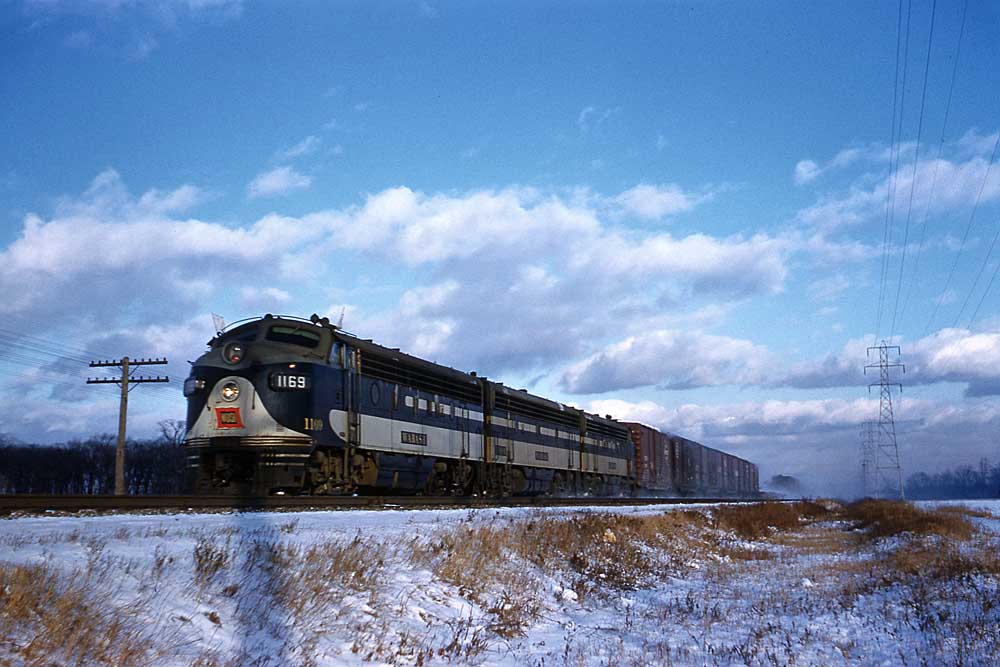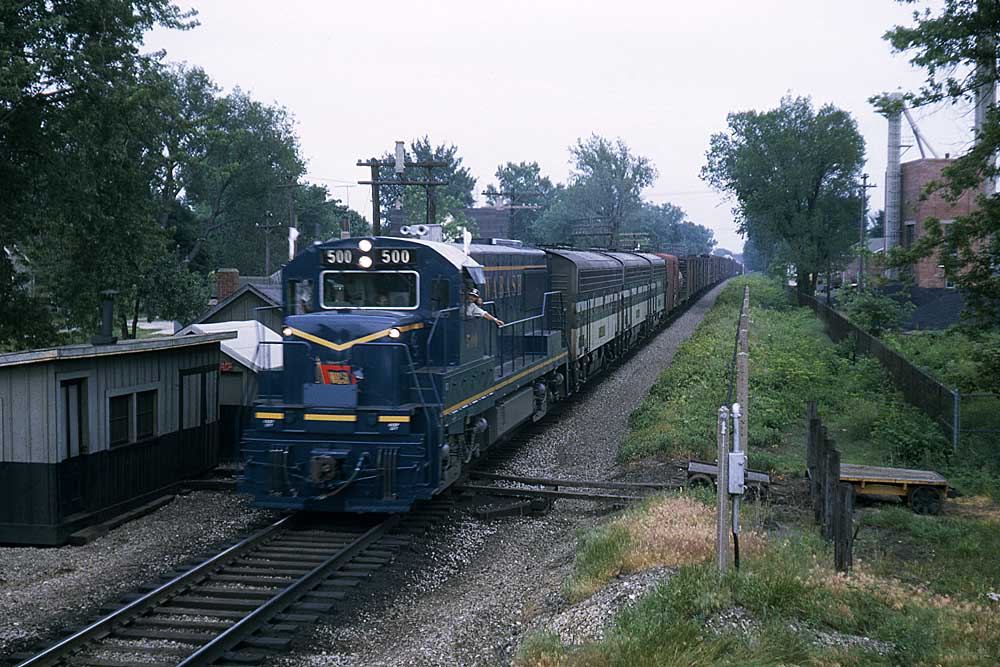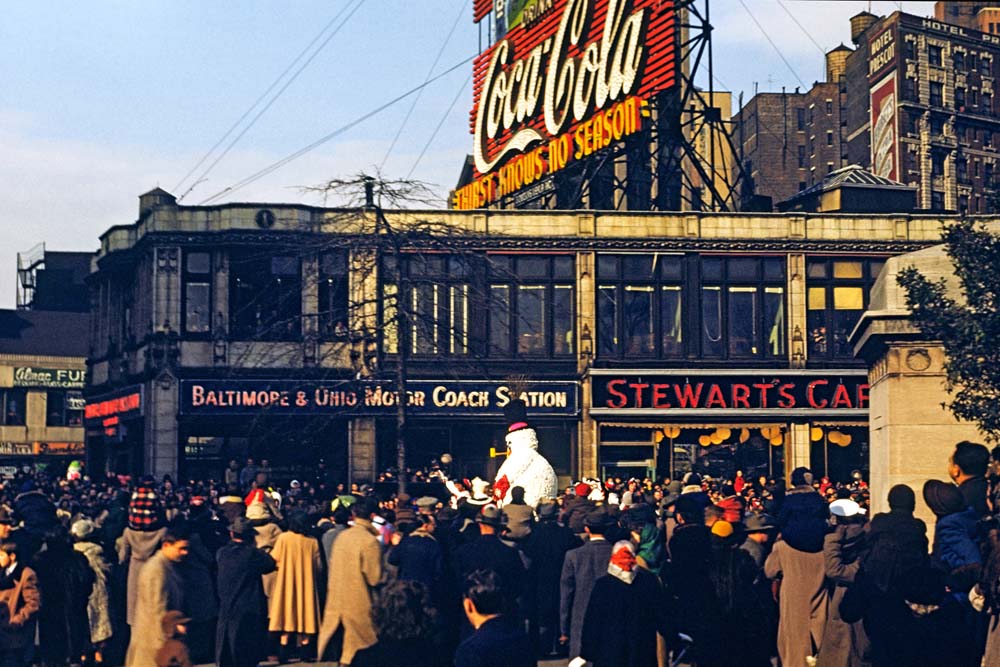Wabash Railway history started with the Northern Cross, the first railroad in Illinois, in 1837.
The term “Fallen Flag” first appeared in Trains in 1974, as the title for a series of thumbnail histories of merged-away railroads. The series began with the Wabash, and employed the road’s flag emblem outline to illustrate the series’ opening pages. Editor David P. Morgan and I each wrote half the thumbnails. One of mine was the Wabash, which served my home territory, as in one of its slogans, “Serving the Heart of America.”
I came to know the Wabash well for much of its last decade, before Norfolk & Western absorbed it in October 1964. Other than pacing a 2-8-2 south of Taylorville, Ill., circa 1950, I had only one Wabash experience before our family moved from suburban Chicago to suburban Detroit in 1956. And that was indirect — my 5th-grade class viewed the railroad’s 16mm public relations movieOnce Upon the Wabash, produced to tout its new Budd domeliner, the Blue Bird.
With more than 100 Class Is in the postwar era, it wasn’t as easy then to connect key points in your life by one railroad as it would be in today’s world of seven mega-systems. Wabash, though, did so for me, and in some ways, I adhered to its emblem’s “Follow the Flag” slogan. My first Wabash ride was a 1957 Detroit-Decatur (Ill.) Wabash Cannon Ball round trip to visit relatives. By 1959 Wabash’s diesel terminal at Oakwood Yard near home had become a regular stop on Detroit-area engine-photography “rounds,” and as a Michigan Railroad Club member, I rode a diesel excursion that year covering much of the obscure 4th District, from Montpelier, Ohio, to Pine, Ind., plus subsidiary New Jersey, Indiana & Illinois up to South Bend.
During 1962-65 I attended MacMurray College in Jacksonville, Ill., on Wabash’s Detroit-Kansas City route. Until my junior year, I didn’t have a car at “Mac,” so when I’d go home to Michigan, I’d ride the Cannon Ball or the overnight Limiteds between Decatur and the Motor City. I left my car in Decatur a time or two, and returned via Chicago, taking the Blue Bird. After 1964, of course, reality was the Norfolk & Western but the Wabash spirit endured as N&W kept the train names. My miles on the City of St. Louisand City of Kansas City were either on Colorado family vacations or visits with K.C.-area friends. I returned to central Illinois and worked for newspapers during 1966-71 before moving to Wisconsin to join the Trains staff.

Wabash Railway history
In today’s terms Wabash was a decent-size regional — 2,423 route-miles in 1960. Wabash’s hot “Red Ball” freights burnished busy high iron as the road took full advantage of its unique position spanning the Mississippi River with a main line that bypassed congested St. Louis and Chicago.
Wabash had three freight hubs — Montpelier, Decatur, and Moberly, Mo. — which anchored a network connecting Detroit, Toledo, Chicago, St. Louis, and K.C., with secondary lines to Des Moines and Council Bluffs-Omaha. It also ran, on Canadian National trackage rights, between Detroit and Buffalo, N.Y., starting in 1898. It employed Detroit River ferries to Windsor, Ont. This effectively made Wabash a link between Lackawanna and other roads to the big Eastern cities and Union Pacific, Rock Island, Missouri Pacific, and others across the Great Plains.
As with many mid-size Class I railroads, Wabash Railway history is one of mergers, consolidations, and leases.
What became the Wabash had early beginnings that included the first railroad in Illinois. The Northern Cross, first of several east-west lines sponsored by the state to aid development, was chartered in 1837 to run from Quincy on the Mississippi River to the Indiana state line. In 1838, it laid 8 miles of wobbly track from Meredosia, on the Illinois River, east toward Jacksonville and the state capital of Springfield; its first train ran on Nov. 8, 1838. Through service to Springfield began in May 1842; Decatur was reached in 1854, and Indiana in 1856. Remarkably, Norfolk Southern still operates essentially all of this route.
Downriver, the North Missouri was set up in 1851 to build from St. Louis to the Iowa border, opening in 1858. In the 1860s NM acquired a branch to Brunswick and established Moberly, named for a railroader, at the junction. The Brunswick line reached K.C. in 1868; to the north, the original route attained Ottumwa, Iowa, in 1870, the year the line from Brunswick to Omaha was begun. It got to Council Bluffs in 1879. NM had stumbled financially and was succeeded in 1872 by the St. Louis, Kansas City & Northern.
‘Follow the Flag’ east
To the east, two roads were organized in 1853: the Toledo & Illinois to build from Toledo, Ohio, to the Indiana border, and the Lake Erie, Wabash & St. Louis to continue to Attica, Ind., following the Wabash & Erie Canal. They merged in 1856 as the Toledo, Wabash & Western, the first time the word “Wabash” entered the picture.
TW&W was succeeded by the Toledo & Wabash in 1858, having absorbed the Great Western of Illinois (a Northern Cross successor); T&W spanned from Toledo to Quincy and Keokuk, Iowa, both on the Mississippi. In 1879 Jay Gould merged T&W and StLKC&N to form the Wabash, St. Louis & Pacific. To it he added the Chicago & Paducah, from Streator to Effingham, Ill., which crossed the WStL&P at Bement. Another Gould road built from Forrest, Ill., on the C&P, into Chicago in 1880, and he also built a line from Butler, Ind., to Detroit. A cutoff from Butler to New Haven, Ind., near Fort Wayne, opened in 1902, enabling Detroit-St. Louis trains to go via Fort Wayne, Huntington, and Wabash, Ind., versus the older, shorter-but-slower Logansport-Butler line, which was sold to the Pennsylvania.
Wabash’s 4th District across northern Indiana, unnoticed by many as it had no modern-day passenger trains, was pushed to completion for the 1893 World’s Fair in Chicago. Built in a straight line from Montpelier to Gary, it passed through no big cities and couldn’t compete with New York Central for passengers. Instead, Wabash used latter-day parent Pennsy on a joint Detroit-Fort Wayne-Chicago route. Although sometimes called the “Punkin’ Vine,” the 4th District had heavy rail and became part of a competitive Buffalo-Chicago freight route. It was Wabash’s first dieselized line (1950) and hosted Indiana’s last mixed train (1962).
As Jay Gould added lines, Wabash in 1884 reached its zenith of 3,549 miles, from Detroit to Omaha and from Fonda in northwest Iowa to Cairo at the foot of Illinois. But he had overextended, and his rate wars forced Wabash into receivership that May. The leased lines — including Cairo & Vincennes and Des Moines North Western — were returned to their owners, and Wabash retrenched to the network familiar to us. Reorganized as several roads, they were reunited in 1889 in a consolidation guided by John Whitfield Bunn, an industrialist and railroad developer from Springfield, Ill.
Jay’s son George Gould also dreamed of including Wabash in a transcontinental system, and in 1904 got it into Pittsburgh from Toledo over the Wheeling & Lake Erie and his Wabash Pittsburgh Terminal. Wabash in Pittsburgh didn’t last long, as WPT entered receivership in 1911. A 1915 reorganization took the name Wabash Railway, and WPT became the Pittsburgh & West Virginia in 1917.

20th century growth
By the 1920s the auto industry was growing, and the increasing traffic saw Wabash taking advantage of its direct Detroit-Kansas City route. The 67-mile portion between Hannibal, Mo., and Moberly had been built by the Katy in the 1850s, but Wabash began joint operation in 1894, with costs proportionate to use. With Katy going to St. Louis on its own, Wabash’s share of the Hannibal branch rose to 90% by 1923, so it leased the line.
Wabash in 1925 acquired control of the Ann Arbor Railroad, which cut northwest across Michigan’s lower peninsula from Toledo to a Lake Michigan port, from where AA ran carferries to Wisconsin and Upper Michigan. Eventually Wabash owned virtually all “Annie” stock. Meantime PRR, through its new holding entity Pennsylvania Co., gained control of Wabash in 1928, largely to protect itself after Wabash and Delaware & Hudson bought control of the Lehigh Valley.
Fast-forward four decades. In 1963 Pennsylvania Co. owned 87% of Wabash’s stock, and when PRR and New York Central were planning their merger, it was clear PRR would not be allowed to include Wabash, which found a niche in the Norfolk & Western-Nickel Plate merger. N&W had no interest in the Ann Arbor, so it was kept in the PRR family by being sold in 1963, to PRR-controlled Detroit, Toledo & Ironton.
The road was leased to the expanded N&W on Oct. 16, 1964, but this did not end Wabash Railway history. Although it looked like a merger, with Wabash continuing to exist only “on paper.” N&W acquired control from Pennsylvania Co. by 1970 and by 1981 had almost complete Wabash ownership. When N&W and Southern merged in 1982, N&W continued to exist on paper, and successor Norfolk Southern finally merged the Wabash name away in 1991 by folding it into N&W.














I was a student at MacMurray during 63-64 and also hung out some at JAX tower which was only a short 3 blocks from my dorm. But I never met David while I was there.
The freights had to slow down going past the tower as just about all of them would have to get orders from the tower via the 2 hoop stand for both engine & caboose.
Both the Q [Burlington] line out of Beardstown and the GM&O branch [ran parallel about 30 miles west of its main line] crossed the Wabash at JAX tower and got any needed orders by hand at the tower.
I can confirm that the Wabash freights in the country really were moving fast, far faster than I ever saw freights in the east.
I enjoyed the “Wabash Remembered” article. The Moberly Division was the western leg of the Wabash and there was a lot of activity here on both the St. Louis line and the Decatur-Chicago line. Most of my family worked for the Wabash (except me!) and my spouse worked in the Moberly Depot for 18.5 years.
Most of the story is parallel to the work of Lloyd Deierling, a railroad dispatcher, and curator of our railroad museum until his death.
One story I recall when N&W began their takeover when the “coal” supervisors came to Moberly to ride the trains. These supervisors apparently “held on for dear life” as they experienced the speed of Wabash freights.
Again, thank you.
Would be of interest to know the traffic make up and train densities on the various lines. I recall seeing Wabash F’s in the Lackawanna yard in East Buffalo and C&O geeps in the Erie’s E. Buffalo yard just before the EL merger. It would be interesting to also know how the C&O and the Walsh split traffic across Southern Ontario and how their running times compared.
The Monticello Railway Museum in Monticello, IL, has a really nice F7A dressed in Wabash livery (it actually was the last F7A ordered by Wabash before being absorbed by the N&W) that takes visitors on rides on a regular basis.
I wish Dave was still with us (died in Oct 4, 2020).